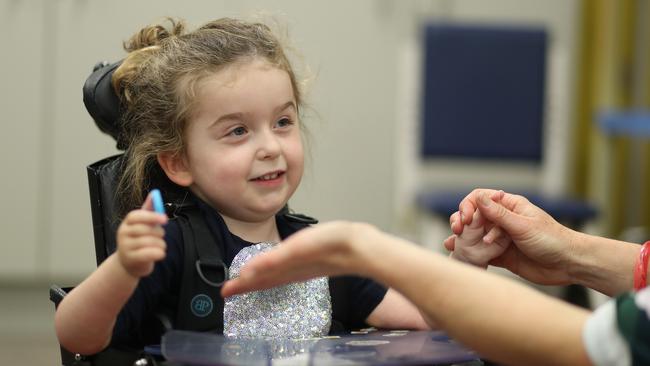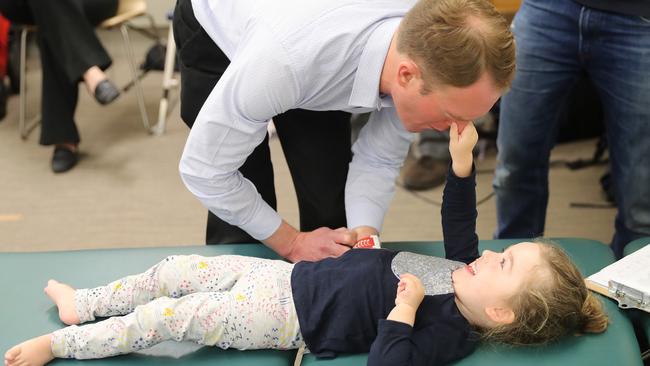How parents’ fight for new drug Spinraza helps daughter thrive despite spinal muscular atrophy condition
This is the remarkable story of young Moriac girl Stephanie Nave who thanks to starting a new drug for spinal muscular atrophy, is miraculously sitting upright and independent in her wheelchair.

Geelong
Don't miss out on the headlines from Geelong. Followed categories will be added to My News.
TO see Stephanie Nave sitting upright and independent in her wheelchair, her arms reaching to catch bubbles, is literally a Christmas miracle.
Ever her physiotherapists who saw the three-year-old at the Royal Children’s Hospital arrive at her latest assessment with the manual wheelchair - one that had no arm rests, no tray table to keep her secure and no electric joystick - silencing scoffed to themselves that this would be possible.
Until they saw it for themselves, they could barely believe her parents Amanda Hulands-Nave and Mark Nave recounting how their daughter who could now wheel herself up the hallway at home, that she could now brush her hair and bring a cup to her own mouth.
“It’s awesome. I thought there was no way she could use that, but it just shows how far she’s come in the six months since starting treatment,” said physiotherapist Kate Carroll.
The Moriac girl was diagnosed with the progressive muscular disease spinal muscular atrophy, type 2, at 18 months of age.
With the physical ability of a four-month-old, “12.5kg of wet spaghetti”as her spinal cord nerves and muscles started wasting away.
Her parents and her doctors pinned their hope on an emerging gene therapy, that replaced to missing survival motor neuron protein critical for the nerves that control muscles.

The international trial of Spinraza was stopped halfway through in 2016 when interim results stunned doctors, and it was only ethical to also give the drug to those on placebo.
It was allowing babies with the most severe type 1, children who would typically die during infancy, start to reach major developmental milestones.
One Melbourne two-year-old boy, whose older sister is severely affected, who received compassionate access to the drug at six weeks old - before he started showing symptoms - has reached all his developmental milestones and is now running.
And yet, without compassionate access, families like the Naves faced finding $1 million for the first year of treatment, and $360,000 annually.
Stephanie’s parents joined RCH’s director of neurology Professor Monique Ryan to lobby the Federal Government for expanded subsidised access to the drug for children with SMA type 2.
It was approved just before Christmas last year and Stephanie was one of the first children in Australia to access the subsidised drug in May this year. About 30 children have received the injection at the RCH this year.
She could blow bubbles for the first time after the first dose of the spinal injection.
Her parents watched in tears at her latest assessment at the RCH, capture in pictures by the Herald Sun, where Stephanie showed off her new found skills of sitting upright on her own, rolling over on the floor and reaching her hands above her head.
While they are small movements, Dr Huland-Nave said they were significant and life changing.
“Everyday we’re seeing things we never thought were possible,” she said.
“This drug came along just in time, because we were faced with the real possibility that Steph wouldn’t be around for much longer without it.
“Now we can start to let ourselves imagine a future for her where she can be independent, maybe stand and even take steps on her own.”
Ms Carroll said the potential of Spinraza was still to be realised, with the main challenge to diagnose affected children early so they could be treated and possibly never show symptoms of the disease.
